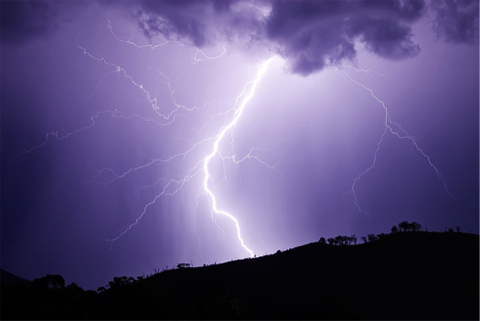Exploring the Mysteries of Thunderstorm Radiation
August 1, 2016
"One one-thousand, two one-thousand, three one-thousand…" There are about 16 million thunderstorms per year, according to The National Severe Storm Lab, and 2,000 happening at any given moment. These storms are responsible for rain and sometimes hail, heavy winds, flash floods, spooked pets, kids diving under the covers, crashes of thunder, bolts of lighting, and flashes of high-energy radiation. Yes, high-energy radiation.

Lightning Strike at Swifts Creek, looking west in January 2007.
Image Credit: Fir0002/Flagstaffotos (CC BY-NC)
As common as thunderstorms are, they still hold mystery. Take lightning, for example; lightning is a sudden discharge of electricity from a cloud to the ground, or from one area of a cloud to another. It happens when some parts of a cloud become positively charged and other parts become negatively charged, but the truth is that we still don’t know exactly how all of this works.
Another mystery is this radiation that accompanies thunderstorms. Using ground-based observations as well as ones from space, airplanes, and balloons, scientists have been detecting high-energy radiation from storms for the last few decades. What is the source of this radiation? How is it related to lightning? Scientists are still exploring these questions.
Studying storms safely is not always easy, but understanding these powerful forces of nature can help us better protect ourselves against their dangers. Understanding what causes lighting and where the radiation comes from may be especially important for the future. A 2014 study cautioned that climate change may lead to more lightning strikes. In addition, uncovering the details of how lightning forms could give us new insight on how to produce and use energy more efficiently.
Using data collected at a science facility located in the northern Tien-Shan mountains in Central Asia, a team of researchers from Russia and Kazakhstan recently completed a systematic study of the radiation inside thunderstorms. Their work was published in the American Physical Society’s journal Physical Review D and gives us a more detailed picture of the radiation over the time span of a thunderstorm.
From Inside the Storm
The data was collected by detectors on the ground at an experimental facility called Groza, which means “Thunderstorm” in Russian. The facility is in the mountains, about 2 miles above sea level. This puts it right in the middle of thunderclouds—the kind that produce lightning. Groza has several different kinds of detectors that can be moved around and modified based on what you want to study.

An old photograph of the Tien-Shan Mountain Cosmic Ray Observatory, where Groza is located.
Image Credit: Photo courtesy of Aleksander Gurevich.
Over the course of several thunderstorms, the team made measurements of the following kinds of high-energy radiation every 10 seconds: gamma rays (like x-rays, but higher energy), high-energy electrons, and neutrons. (While these last two are particles, they can be emitted at high speeds by high-energy processes, and these emitted particles are included as a type of radiation.) This type of monitoring study has been done before, but usually the radiation is measured every 5 minutes or so. The team also took measurements when no storms were happening so that they could compare the results.
The results clearly show two types of high-energy radiation produced during thunderstorms. The first lasts for about 10 minutes but can go on longer, and seems to start at the same time as rain or other precipitation. Their data appears to support an existing hypothesis that this radiation is caused by radioactive gases such as radon coming down from higher in the atmosphere./p>
The second type of radiation is short, very intense flashes of high-energy gamma rays and energetic elections. These last for a fraction of a second, but are so intense that you can still see the signal even if you only take measurements every 10 seconds.
In order to study these short flashes in more detail, the team correlated radiation measurements to lightning strikes. The start of a lightning strike is accompanied by a large radio signal. Whenever this kind of radio signal was detected during the experiment, it immediately triggered measurements from the other detectors.
The researchers found that the timing of the short, intense flashes they saw using the first method matched very well to the start of a lightning strike as determined using the second method. The group also saw a significant increase in the number of neutrons produced right around the start of a lightning strike that can’t be explained by current models. That’s another mystery for scientists to investigate.
Although the radiation levels of thunderstorms have been measured before, this is the first time that scientists have combined these two methods—taking measurements at intervals short enough to show the flashes and overlapping them with information on the exact time lightning begins. They also estimated the energy range of the gamma rays and electrons they detected, which matched previous studies well.
Overall, the results add both information and questions to the thunderstorm puzzle. They indicate that even more complicated things are happening in thunderclouds than previously thought, say the authors. As a next step they suggest taking measurements over even shorter intervals, like 10 nanoseconds, which would shed more light on the source of the radiation and the validity of proposed explanations.
From Space
Not only are scientists exploring the radiation inside thunderclouds, they are also exploring high-energy radiation from lightning rocketing off into space. In the early 1990s, a NASA spacecraft accidentally discovered short, intense gamma ray flashes originating in the Earth’s atmosphere. These flashes were linked to lightning from thunderstorms here on Earth, and a 2015 study showed that even weak thunderstorms can produce very energetic terrestrial gamma-ray flashes. Although this is not what the scientists at Tien-Shan studied, it’s a related and equally fascinating area of research.
From the Window
If you’ve been through more than your fair share of thunderstorms, don’t worry. Although they produce some intense radiation, you wouldn’t be exposed to enough radiation to cause any damage. Lightning, flooding, and high winds pose a much greater danger. A few years ago a theoretical study suggested that if passengers in an airplane were at just the right place at just the right time, a rare type of lightning could expose them to high levels of radiation without anyone knowing. This possibility hasn’t been confirmed by experiments and if it is the case, the odds of it happening are extremely small. So next time you’re in a storm don’t worry, just head to a safe place, sit back, relax, and enjoy the show. Hopefully in a few years we’ll have an even more robust scientific explanation for the forces of nature you’ll see.
—Kendra Redmond














